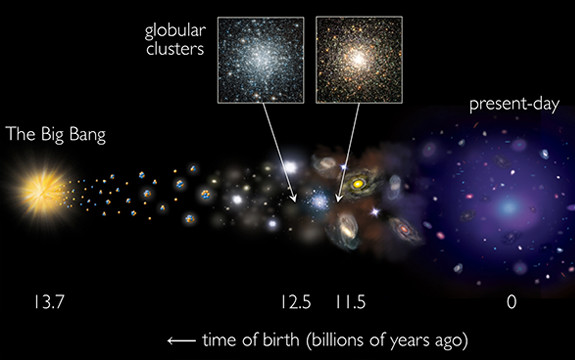Fossil star clusters reveal their age

In Summary
Using a new age-dating method, an international team of astronomers has determined that ancient star clusters formed in two distinct epochs – the first 12.5 billion years ago and the second 11.5 billion years ago.
Although the clusters are almost as old as the Universe itself, these age measurements show the star clusters – called globular clusters – are actually slightly younger than previously thought.
“We now think that globular clusters formed alongside galaxies rather than significantly before them,” research team leader Professor Duncan Forbes of Swinburne University of Technology said.
The new estimates of the star cluster average ages were made possible using data obtained from the SAGES Legacy Unifying Globulars and GalaxieS (SLUGGS) survey, which was carried out on the Keck II telescope in Hawaii.
Observations were made over many years using the powerful DEIMOS multi-object spectrograph fitted on Keck II.
DEIMOS breaks the visible wavelengths of objects into spectra, which the team used to reverse-engineer the ages of the globular clusters by comparing their chemical composition with the chemical composition of the Universe as it changes with time.
“The Universe is now well known to be 13.7 billion years old.” Professor Jean Brodie from the University of California, Santa Cruz said.
“We have found that globular clusters formed on average some 1.2 and 2.2 billion years after the Big Bang.”
Professor Forbes said the age measurements indicate that globular clusters managed to avoid the period, called cosmic reionisation, in which the Universe was bathed in a lot of ultra-violet radiation which could have destroyed them.
“Now that we have estimated when globular clusters form, we need to tackle the questions of where and how they formed.”
The SLUGGS survey is comprised of an international team of astronomers who aim to understand the formation and evolution of galaxies and their globular cluster systems.
Globular clusters are tightly bound clusters of around a million stars. Most large galaxies, including the Milky Way, host a system of globular clusters. Although the Universe itself, and galaxies within it, has evolved over cosmic time, globular clusters are very robust and many have survived intact for over 10 billion years.
The team of astronomers includes researchers from Swinburne University of Technology (Australia), University of California at Santa Cruz (USA) and San Jose State University (USA).
The results of this work are published in Monthly Notices of the Royal Astronomical Society.

